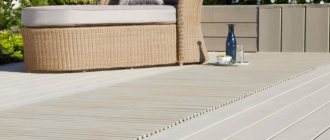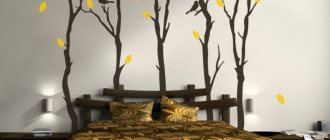History of origin
A dry stream for landscape design came to us from Japan, where it became the personification of water, without which not a single Japanese person can imagine life.
For the inhabitants of the Land of the Rising Sun, water is a symbol of continuous movement and the desire to learn something new.
Here such a stream has long become the main element of rocky gardens. After all, he was able to successfully supplement the landscape with imitation water in those places where it is not possible to create a real body of water.
Application options
A dry stream in the design of a suburban area is not only a spectacular element. It will also cope well with practical functions. It will allow you to visually expand your area, perfectly hide some shortcomings and highlight your advantages.
Clouds of mosquitoes and other bloodsuckers that can turn a person’s life into a real nightmare will not gather over a dry stream.
With the help of this unusual element the following is achieved:
- All year round your site looks well-groomed and stylish;
- Utility pipes, sewer manholes and some landscaping imperfections are elegantly hidden by a “flow” of pebbles;
- Zoning of the site was carried out effectively and conveniently;
- An unusual look for the landscape, thanks to the use of decorative elements such as bridges, swings, sculptures and a gazebo;
- The ability to use a variety of plants for the territory: from centuries-old pines to annual grasses.
A dry stream will easily fit into a site of any size and shape and decorate it with its unusualness and originality.
Benefits of a dry stream
A dry stream in landscape design is always beautiful and still unusual. It becomes a real decoration of any site, visually expands the space, hides some imperfections in the relief or communications. It will perfectly decorate lowlands and hills, and will decorate shady places and sunny meadows.
A dry stream in the garden will never become a haven for mosquitoes or the unpleasant smell of stagnant water. It will not wash away the banks and will not harm children or animals.
This decoration can serve as a small drainage ditch.
A dry stream is not at all difficult to make and will not take much effort or time. And from a financial point of view, such decoration will not require large cash injections.
Such a garden miracle will not require special care; its creation does not require filters, pumps, compressors, or durable film.
Benefits of a dry stream in your backyard
There are a number of positive qualities of such decoration for a garden plot. These include:
- easy installation. Here you don’t need expensive equipment and special tools to create a dry stream with your own hands;
- minimal care. After erecting the structure, it is recommended to remove weeds and small grass between the small pebbles. To prevent this phenomenon, a layer of geotextile is laid at the bottom of a dry stream. It allows water to pass through perfectly and blocks the growth of unwanted vegetation;
- beautiful appearance regardless of the season;
- corrects minor defects and imperfections on the surface of the landscape;
- fits perfectly into the landscape space of a personal plot;
- goes well with any type of ornamental plants;
- allows you to create a balance between plants and architectural structures;
- environmental friendliness. Only natural materials are used in this structure. These are mainly: stone, pebbles, decorative chips;
- visually increases the area several times.
Types of dry streams
A garden landscape designed in such an unusual way can be decorated with a single channel, gently flowing through the territory or a separate part of it, several channels that will run along paths, entwined with flower beds and gazebos.
On a large plot, you can create a whole lake from which stone water will flow out, or into which it will flow.
And on the slopes you can build entire waterfalls, decorated with artificial rapids made of large stones.
Rock water can have smooth outlines, or it can narrow and expand, simulating uneven soil.
Types of streams and waterfalls: choosing the right one
Streams and waterfalls, in common landscape design terminology, refer to the dynamic form of water. Thanks to its fluidity, in addition to visual ones, sound effects of perception are connected: splashing, murmur. Static form, that is, ponds and pools, due to immobility, contains only a visual component. Therefore, for those who want to enjoy the tamed water element to the maximum, we recommend paying attention to streams and fountains.
Regardless of the chosen option for moving water, the principle of implementing this landscape mini-project remains the same. The water flow is looped: it moves with the help of a pump from the lower storage tank through the hose to the upper one, and then flows down again. This scheme of work is considered universal, because a natural source on the site is a huge rarity.
A stream in nature is a water stream flowing from a source to a lake, and on a personal plot the role of these two points is played by reservoirs. An artificial stream is created with turns, bends, areas along the length of the riverbed, and its appearance is complicated by waterfalls or fountains. The difference is that fountains are forcibly created under the action of a pump, while waterfalls arise spontaneously due to elevation changes on the site.
Wide stream on the plot
An artificial source is not some extraordinary phenomenon in landscape design. A stream can be created on any uneven area with a water supply and the ability to operate a pump. Depending on the topography of the area where it flows, several types of streams are distinguished.
- The bed of a calm stream with a quiet murmur is located on gentle slopes or completely flat terrain.
- A stormy and loudly babbling stream - on steep slopes.
It is better to avoid forming a stream with a very winding bed and numerous embankments, as well as any clear geometric shapes. The optimal reference point will be natural streams with their smooth bends, uneven banks and heterogeneous bottom.
To prevent the stream from turning into a series of waterfalls, do not get carried away by its complications in the form of sudden changes in relief. In addition, such a source will require the installation of a more powerful pump.
Architectural waterfall
A characteristic feature of a waterfall that distinguishes it from a stream is the pronounced differences in height along the length of the riverbed. It is worth considering: the sounds of loudly falling water can be annoying, so preference should be given to moderately wide rather than tall, narrow waterfalls. But a channel elongated in a horizontal plane is not the best solution, because the water flow will be weak. To activate it you will need a powerful pump.
Tall plants or buildings surrounding the waterfall will help muffle the noise. When arranging a waterfall, like a stream, on a standard garden plot, it is better to strive to imitate natural forms, soft and asymmetrical.
There are several types of waterfalls for a personal plot.
- Cascade. Water flows from the upper to the lower bowls, that is, along the steps of the cascade. For a cascading waterfall up to 1.5 m in height and steps up to 0.5 m wide, you will need a pump with a capacity of up to 80 l/min. If the height and width of the steps exceeds 2.5 m - about 450 l/min. You should buy a pump with a power slightly higher than necessary, since part of the energy is spent on related processes.
Cascade stream is characterized by the presence of several fairly high steps
- A flowing waterfall with almost even cascade steps. Water flows smoothly from one level to another with a quiet murmur.
Stream with flowing waterfalls – gentle
- A “dry” waterfall is called so because of the absence not of the liquid itself, but of a visible reservoir for it, that is, a pond or pool. The water flows into a container hidden underground, for example, a concrete pit with a pump inside. Sometimes such a reservoir is not buried, but covered with a lattice entwined with plants.
A dry stream with a waterfall has no visible lower reservoir
- Waterfall “wall”. Such compact waterfalls are often installed in public spaces or indoor spaces. Water flows over a solid surface: glass or the wall of an artificial grotto.
Miniature waterfall wall
- Waterfall with grotto. This is a complex structure, the construction of which requires a professional approach. The walls of the grotto with holes through which sunlight shines are made of cement mortars on a reinforced base. The walls contain supporting load-bearing structures. The structure itself is installed on a concrete base. The inside of the grotto is illuminated. There is a pump running in the pond surrounding the grotto.
Waterfall with a voluminous stone grotto
- The pumpless waterfall, known as Heron's Falls, operates on the principle of communicating vessels. Thanks to pressure differences in multi-level containers, a stream of water is created. Using simple formulas, you can make a miniature waterfall yourself. Another option for a waterfall without a pump can be implemented if groundwater lies close to the surface of the earth on a personal plot. It is necessary to dig access to the water, make a conclusion for it and a cascade channel directed downwards. For such a natural waterfall, it is necessary to provide a discharge into the sewer system or into a storage tank.
The suitable type of waterfall or stream has been determined, and the time has come to choose its appropriate stylistic design, which depends on the general concept of landscape design on the site.
- Minimalism: laconic decor and strict geometric shapes, like dry fountains. Also, water can flow from smooth slabs into a round or square bowl. In the center of such a body of water, an island in the form of a cube or ball with jets gushing out looks organically. Stone of different textures, ceramics, metal, concrete, glass fit into the minimalist style.
Waterfall wall in minimalist style
- Classical style: characterized by decor in the form of statues or amphorae, cascading and island waterfalls as a common design method. The classic style corresponds to natural materials, in particular stone: both polished and untreated.
The classic fountain is highly decorative
- The natural style recreates natural landscapes through the use of natural shapes and materials. The existing topography of the site is used to the maximum, including the stones located on it - for decoration and the construction of cascades.
Artificial stream in natural style similar to natural one
- The Mediterranean style is characterized by handicraft and carelessness. Thus, a fountain may have an elaborate geometry, including several cascades, but the feeling of warmth is created by raw stone and ceramics, decorated with mosaics or glaze.
Mediterranean style - cozy and lively
Using dry streams
In addition to their decorative properties, small rocky streams will help in dividing the site into functional zones, covering pipes and drainage ditches.
They will do an excellent job of visually correcting a garden plot: meandering streams will give it a larger area, a lake will shorten an overly elongated plot of land.
Dry stream design
For amateur flower gardeners, the design of a dry stream opens up a huge field for creativity: almost any plants can be planted near it, not just those that love plenty of moisture, so the bank can be enlivened with hosta, ferns, daffodils and all other flowers that will appeal to the owners of the site .
A DIY master will be able to build a small decorative bridge, wooden walkways or a cute mill.
And the smallest plot owner will be able to plant plastic frogs along the stream.
Stages of creating a dry stream
You can create such a “cherry on the cake” quite quickly. If you wish, you can do it in just a couple of days, one of which will be spent arranging the “bed” and filling the stream with stones, the second will be needed to decorate the banks.
Moreover, this time can be found not only at the height of planting, but also throughout the entire gardening season.
Features of a dry stream and its advantages
A traditional dry stream consists of small, smooth stones like pebbles that create a simulated water surface, as well as large stones that simulate rapids or waterfalls in the area. In addition to these elements, other details are installed to create accents on the dry stream area and make it even more presentable.
But not only the original appearance can be considered an advantage of such a decorative object. Here are a few more benefits of dry streams:
- you can form a dry stream in your dacha with your own hands without the involvement of specialists and significant costs for arrangement;
- you can create such a relaxation corner in just a couple of days: all you need is to decide on a place and carry out a few simple works;
- caring for a dry stream is not difficult, since all you need to do is adjust its shape if necessary;
- Unlike water bodies, algae and sediment do not accumulate in such a stream. You will save on compressors and cleaning mechanisms;
- weather conditions will not affect the appearance or quality of the materials used, so the dry stream will serve you for many years;
- if you want to plant flowers or other vegetation next to a dry stream, you will not have to focus on the sensitivity of green spaces to moisture;
- mosquitoes will not gather above dry streams, so you will ensure yourself a rest without discomfort;
- such a stream is safe for a child, and you don’t have to worry about him when relaxing in the fresh air;
- stones in a dry stream can be used to mask individual communications, while maintaining access to these elements.
Attention! It is also worth noting the functionality of such objects. Dry streams can be used as drainage to carry away rainwater in the garden or as storm drains along paths.
Dry streams also help solve some of the difficulties associated with the terrain. For example, if there is a slope, a stone flow created by yourself will make it possible to give an organic appearance to this area. And if you plant flowers and herbs nearby, such an area will become even more expressive, and the green spaces will look appropriate.
An alpine slide with a dry stream or other objects with such a decorative element will emphasize your sense of style and individuality.
Dry stream design, photo
Materials
A stream for landscape design can be made from the simplest materials, many of which often lie completely abandoned. Most often, crushed stone or pebbles become water, and it is better to decorate the banks with larger stones and even small boulders. Often large stones are installed in the “water” itself.
For those who want more believability, you can use special blue pebbles, mosaics, blue granules or decorative balls.
Such materials are not much more expensive, but they look more impressive.
Photo gallery
Look at another small selection of photo ideas of dry streams and options for their use in landscape design of the site:
Site planning
When creating such a composition, it would be logical to start from the source and end at the mouth.
The source (the place where the stream forms) can be located on a small hill or hidden among fluffy flowers. Sometimes large stones are poured as a slide, from which small pebbles begin their journey.
The mouth can be made in the form of a lake or hidden behind a fence and green spaces.
Step-by-step instructions for arranging a stream
So, we briefly explained what an artificial stream is.
If you can find an area of uneven terrain, provide a water supply and purchase a submersible pump, you just need to learn a few technical nuances and then you can get down to business. The best time of year for construction work is spring or summer; it is better to preserve the reservoir for the winter period.
Layout: location, direction, dimensions
The first stage, preparatory, is at the same time the simplest and most difficult. To implement it, you will need office supplies: pencils or markers, a ruler and a large sheet of paper, preferably graph paper or squared paper.
On paper it is necessary to display all the objects already existing on the dacha territory, including the house, garden, paths, etc. Pay special attention to the area where your stream will be located.
Think about where its source and mouth will be (the direction of the flow depends on them), to what height the top point needs to be raised, how the banks can be decorated, whether it is possible to use ready-made flower beds or decorative objects to decorate the coastal zone
Keep in mind that the stream forms an area of high humidity, so it is necessary to consider planting moisture-loving or aquatic plants.
If there is a vegetable garden or flower garden with exotic flowers nearby, consider whether additional moisture will harm the already planted crops. The same applies to garden trees, shrubs and even wild flora.
The best place to locate any reservoir is the so-called recreation area - a small area located away from flower beds, beds and fruit tree plantings. Usually in such a place they install a bench for relaxation, a table for tea drinking, and if space allows, they erect a gazebo or place a patio
The length of the stream can vary: perhaps you prefer compact compositions or, on the contrary, you need a source that crosses the entire garden plot, going around buildings and flower beds. But remember: the longer the channel, the more difficulties with its arrangement, and the main problem concerns the slope of the terrain.
The width of the channel usually does not exceed one and a half meters, but more often it is from 30 to 50 cm. Depth is from 15 cm to half a meter. Please note: the larger the volume of water, the more powerful and expensive the pumping equipment
Do not forget that our stream is decorative, and this is its advantage. You can make a completely sealed riverbed and pond so that water from the source does not penetrate into the coastal soil.
The coastline will remain constant and will not be eroded by water in the spring, as happens in natural reservoirs during the snowmelt period.
Instructions for channel arrangement
The main stage is the construction of the channel. Let’s break it down point by point to make it easier to work with:
- We carry out markings on the ground. When developing the project, you have already determined the location of the stream, its size, source and mouth points, all that remains is to transfer the markings from the paper diagram to nature. This will require small pegs and a ball of twine. We stick pegs along the proposed riverbed and connect them with twine or cord to outline the boundaries of the future reservoir.
- We dig a ditch under the riverbed and a pit in which there will be a pond - the end point of our stream. A pond is not only a picturesque object, but also a necessary functional part of our project, since it is in it that we will place the pump that supplies water to the source.
- We prepare the soil and concrete the riverbed. If you have chosen a mountain stream, we place stones, boulders, slabs in any form, and fasten them with concrete mortar. A flat stream requires a gently sloping base with smooth bends. The result should be a trench of a given width and a volumetric bowl for the pond.
- We lay a waterproofing layer - cover the entire working surface with geotextile or a special waterproof PVC film (butyl rubber), secure the edges with stones, pebbles, and sand.
- Along the riverbed, from the pond to the source, we dig shallow trenches for laying a hose or pipe.
- We decorate the bottom of the reservoir with sand, multi-colored granite crushed stone, pebbles, covering all artificial details as much as possible.
- We supply water, fill the pond, test the pump.
A pond is not really necessary, but if you don't have one, you will need a deep container to collect the water and house the pump, such as a large plastic container.
Recent Entries
Lilac perennials that are beautiful, compact and do not crowd out other plants Why when buying seedlings you should not take the sellers’ word for it and how to determine the age of the plant using 3 signs Tomato seedlings have turned purple or whitish: why the color has changed and how to save the plants
Before installing the pump, carefully read the instructions and double check that the technical characteristics of the equipment correspond to the volume of water that needs to be pumped
If the soil is hard, rocky, and the length of the stream is short, additional concreting will not be required. It is necessary to stabilize the riverbed if the water flow is more powerful.
When creating a stream design, do not be afraid to use your imagination: create small rapids, sandbanks, stone islands. Involve children in the work - creating an artificial reservoir perfectly develops creative imagination and introduces some laws of physics
Coastal decor and small architectural forms
When the technical work is completed, you can begin to decorate the banks and riverbed with all kinds of decor. These can be small architectural forms made of wood - a bridge, scaffolding, arches, as well as picturesque statues, funny ceramic animal figurines, flowerpots for moisture-loving plants, wooden boats and rafts.
A bridge is appropriate if a stream is crossed by one of the garden paths - it is its continuation and fits harmoniously into the overall composition
The construction and design of the bridge depends on both the surrounding area and the size of the stream. A large stone structure against the backdrop of a brisk stream 30 cm wide would look more than ridiculous, but small wooden bridges would come in handy.
Heavy structures are good for decorating a large body of water, so if you still want to build a real bridge, use the area of a pond, not a stream.
The material for construction should be natural, as well as the frame of the riverbed, that is, finishing made of stone, ceramics or wood is welcome
A small open pavilion for relaxation or an area with a table and benches would look good on the shore. Try to ensure that the design of the buildings matches the style of the suburban area.
A mini-pagoda against the background of a wooden frame with a carved ridge will look quite strange, and a cozy gazebo with openwork carvings instead of walls is just in place
We plant plants along the banks of the stream to emphasize its naturalness, but given the decorative nature of our structure, we can safely use trays or containers with herbs.
Flowerpots on high legs with hanging plants, compositions with aged pottery, decor made of stones and hand-made wood products, for example, a miniature water mill, are suitable.
Flora of the reservoir
All crops intended to decorate a stream can be divided into two large groups: those growing along the banks and those located directly in the water.
Both categories include herbs with beautiful carved or smooth leaves, as well as plants with inflorescences of various colors.
Don’t forget about lawn grass if there is a lawn nearby, or moss and lichens if there is a small park on the shore. Trees, shrubs and herbaceous crops must be alternated with artificial decoration, stones, scatterings of pebbles and sandbanks
Lushly blooming bushy flowers will cover the bed of the stream, so along the banks, along the water's edge, we plant low-growing plants: loosestrife, creeping loosestrife, multi-colored primroses, daisies, low-growing speedwell, marigold, marsh violets, goose onions, spleenwort.
A little further from the shore there are taller specimens: fern, ostrich, common bracken, female moth, shield grass, hosta.
Plants can be grouped, selected by height or splendor, or alternated, making a variety of floral arrangements from a variety of species and varieties
If the plant composition includes trees or shrubs, select low, moisture-loving species that grow in the wild along the banks of water bodies: goat or white willow, evergreen mahonia holmifolia, caragana tree, Thunberg barberry, cotoneaster, euonymus.
Some shrubs, for example, forsythia or lilac, in addition to beautiful blooms, will give a fresh spring aroma, which can also be enjoyed while relaxing on the shore of a pond
Elodea or urut can be planted directly at the bottom of a stream or pond, if it contains fertile soil, while bladderwort or hornwort do not take root, but float freely on the surface of the water surface.
Egg pods, water lilies, water lilies and marsh flowers feel great even in the northern regions, therefore they are permanent residents of both wild and cultivated Russian reservoirs
Channel planning
Having decided on the beginning and end of the stream, as well as its shape (straight, winding, with one channel or several), you can begin to create a channel. Most often, ordinary sand is used as a marking, which will outline the boundaries of the designers’ creativity. The sand stands out well on the ground, so you can immediately understand what needs to be corrected or changed.
Creating a channel
When the shape and size of the stream have reached complete harmony (from the point of view of the site owners), the top layer of soil is removed by about 10-15 centimeters. A deeper channel will appear unnatural.
A film is placed in the dug groove and sand is poured. This simple device will help prevent weeds from sprouting.
Geotextiles or polymer film are best suited, but if they are unavailable, ordinary construction or decorative polyethylene will do.
Small pebbles are carried into the riverbed, laid out quite closely to each other. At the same time, they can creep onto neighbors, create small hills, and have completely different shapes and colors.
Creating a stream
When all the necessary elements have been purchased and selected, you can begin work on creating an original decoration.
Making a dry stream with your own hands step by step is not particularly difficult, so even inexperienced owners of a plot of land can create it.
- Step 1. Channel planning. The boundaries of the future creation are outlined with sand. This material is clearly visible on the ground, and the border can be easily moved to another location. To give authenticity, the riverbed is made of different widths and gently curved around obstacles.
- Step 2: Removing the soil. The riverbed will need to be deepened a little. To do this, soil is selected from the delineated area. Ten to fifteen centimeters is enough; a deeper channel will not look entirely natural.
- Step 3. Sand filling. Geotextiles are laid at the bottom of a shallow trench (ordinary polyethylene film is also suitable), and a layer of sand is poured onto it. This simple covering will help control weeds. If the stream is planned as a drainage ditch, polyethylene is not laid.
- Step 4. Laying stones. Large stones will represent the banks of the stream; they are laid first, just like the “thresholds”. The riverbed is covered with small stones, trying to avoid open spaces. In this case, stones can creep on top of each other, creating small hills and whirlpools.
- Step 5. Decoration. Plants are planted along the banks; a couple of flowers can be planted inside the stream, carefully moving the stones apart and pouring in fertile soil. Installing decorative elements will complete the creation.
Creating banks
Larger stones are placed on the boundaries of the resulting stone flow, forming the banks of the creation, or plants and flowers are planted. Representatives of the flora can also be planted between boulders.
However, it must be remembered that too tall plants can destroy all the beauty of a man-made stream. Most often, small plants are used here: marigolds, saxifrages, hosts, daylilies, and lobelias.
Care
A dry stream will not require much attention. It only needs to be watered periodically, since stones in the sun tend to heat up, drying out the soil next to them. Which the plants won't like very much.
As necessary, the stream is weeded and the plants around it are pruned.
If there are ants on the site, then they will really like such a structure, so it is recommended to periodically inspect the water area before the construction of anthills begins and take appropriate measures.
In humid climates, stones may become covered in moss, so it is best to wash them periodically.
Photos of a dry stream will help you choose the most interesting design and decorate the area with a pretty stream.
Preparatory work
Now let's find out how to make a dry stream. First you need to think about the location, shape and parameters of such an object. Draw for yourself a diagram of a dry stream - and then transfer its contours to the desired surface. Recreate the bends using twine and sand (we advise you not to give them a strict geometric shape, but to make them arbitrary). Form the source of the stream on a hill.
When calculating the depth of the channel, you should take into account the width of the decorative element being created. Ideally, it should be twice the depth. For example, when creating a stream 1.5 meters wide, you should make it 75 centimeters deep. Now you can begin the process of digging the base under the dry stream in the garden.
Remove the top layer of turf and shape the trench walls at a 45-degree angle. Remove excess vegetation and debris, get rid of roots - and compact the soil horizontally and on slopes.
Unlike water bodies, for such an artificial stream we will not have to form a concrete base with water-resistant properties. To maintain the shape of the stream, cover the made ditch with any material of good density, for example, lutrasil, roofing felt or polymer film.
How to make a dry stream with your own hands, photo











